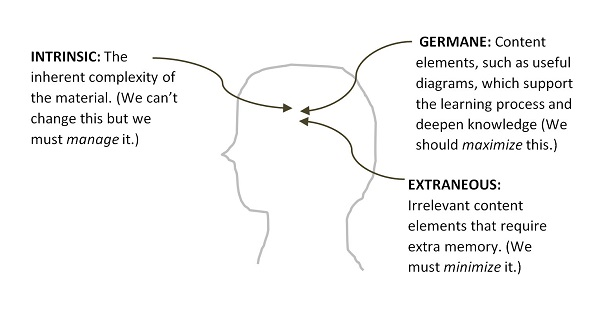ATD Blog
Science of Learning 101: The Case for Less…Generally
Thu Apr 09 2015

One of the issues to consider when designing instruction is how much instruction to provide. This question isn’t always considered, though, and we either provide too much instruction (or not enough).
This brief story will emphasize one aspect of this problem.
Joanna, a new hire in food service at the local hospital, is using an online course in hand washing. The course contains key facts about germs and how hand washing destroys them, but also statistics about hand washing, facts about different types of hand sanitizers, and the history of hospital-acquired infections and how they spread.
The primary message is that feces contains life-threatening germs and that tiny amounts often get onto hands after using the bathroom or handling objects that others have touched. People in the hospital often have compromised immune systems and if they come into contact with these germs, they can get very sick or die. Hand washing can prevent spread of these germs.
The problem: There is so much other information in the course that Joanna doesn’t get the seriousness of the message. She mostly comes away understanding that it’s a “very old issue.” Joanna passes the quiz but misses the critical message.
Consider people handling the following work tasks:
Situation A: an accounting clerk in an accounts payable department has a vendor on the phone with a question she doesn’t know the answer to
Situation B: an armed guard at secure military facility gate is talking to a driver who is acting aggressively and trying to hand him a wrapped package to deliver
Situation C: an air traffic controller sees two planes on the screen who will shortly be in each other’s air space.
We often build training as if everyone needs to know everything about everything. And it’s easy to overload working memory and make it so people learn less than we want them to.
We say it’s the SMEs fault. They gave us too much content. But that’s like saying a poor building design is the architect’s fault. Oops it is! And in this case we are the architect. We need to make sure people learn what we need them to learn.
Cognitive Overload
One reason why we need to provide only what people need is explained by “Cognitive Load Theory.” Cognitive load theory states that we have mental “bandwidth” restrictions. In other words, our brain can only process a certain amount of information at a time. And one of the things that can cause overload is too much information. Figure 1 is a diagram that shows the three types of cognitive load.
Figure 1. Three Types of Cognitive Load

(Source: Patti Shank and Cecelia Munzenmaier, Writing Better Learning Content)
When Learners Don’t Need to Know Everything
Do we need to train the accounting clerk in situation A on every answer to every possible vendor question? Probably not. For that matter, why shouldn’t we train everyone on everything?
People don’t have unlimited time.
The important information will be drowned out by the “just-in-case” information. See the example of Joanne’s hand-washing training. And no, it’s not because they remember 10 percent of what they read, 20 percent of what they hear…
If there’s too much information, it’s easy to get overwhelmed (see Cognitive Overload section).
I hear you asking, “Where will they get other information if they need it?” This may be non-obvious, but they’re probably not going to go open their previous training materials to find the answers they need. So build performance support materials (or have them do it). Let people get help from their social network.
But Some Workers Do Need to Know Everything
On the other hand, the workers facing the issues in B and C don’t have time to look up or ask someone the proper response. They need to know what to do in these situations, and how to do it effortlessly--even if these situations don’t happen very often. We call this “automaticity.”
Automaticity is the ability to do a task effortlessly without any conscious effort or attention. Making something automatic includes accuracy and speed. Automaticity frees the mind to do other things, such as assess the situation, determine what is important, and find alternatives. Benefits of automaticity seem to be consistent across cognitive, perceptual, and motor tasks. But methods for training to automaticity for these different types of tasks are different (see resources). And training to automaticity requires a lot of work for the training designer and the learner.
We make fun of rote learning, but in some cases, it’s required—especially when dealing with the need for automaticity. The alphabet is an example of where rote learning is required in order to move on to more rote learning for reading proficiency and fluency.
Not many tasks require the kind of automaticity described in examples B and C, but many do require the capability to recall information quickly, such as answering guest questions at a hotel desk while others are waiting or medical staff helping patients and families during pivotal moments.
Imogen Casebourne wrote a good Science of Learning blog post about supporting the learning and remembering of this type of information.
Key Point: If the task doesn’t require quick recall or the worker has time to look it up, it may be a waste of training time to add the additional recall practice.
References
Thalheimer, W. (March 12, 2015) Debunk This: People Remember 10 Percent of What They Read, ATD Science of Learning Blog.
Holt, B., & Rainey, S., (April 2002). An Overview of Automaticity and Implications for Training the Thinking Process, Western Kentucky University.
Casebourne, I. (January 27, 2015). Spaced Learning: An Approach to Minimize the Forgetting Curve, ATD Science of Learning Blog
